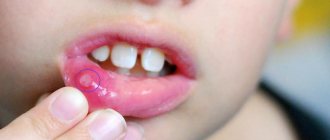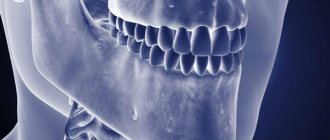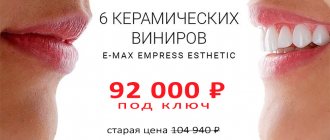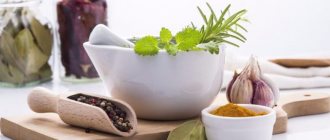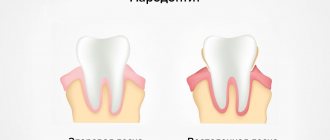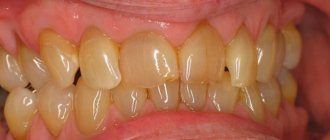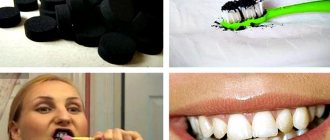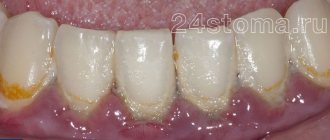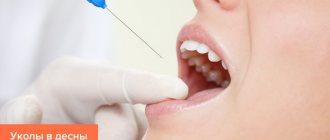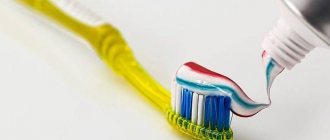1850
The beneficial properties of garlic were known to ancient healers. With its help they were saved from various diseases, restored youth to the skin and hair, and eliminated toothache.
Today, there are also many people who prefer garlic to tablets for toothache and at the same time consider it a more effective remedy.
Composition of the enamel layer
It contains hydroxyapatite crystals (97%), water (2–3%) and organic substances (1–2%). The condition of this hard tissue does not remain unchanged throughout life. The thickness of the enamel is approximately 0.01 mm (in the cervical area) and 2 mm (on the chewing surface). The process of loss, that is, leaching, of beneficial minerals (in particular, calcium and fluorine) is called demineralization. Because of it, the strength of the teeth is reduced and the integrity of the teeth is compromised.
We will discuss the question of how to restore and strengthen tooth enamel at home further. Remember that the first visible changes begin with the appearance of white spots, and later they turn into carious cavities.
Causes of destruction of hard tissues
Here are the main provoking factors for the occurrence of a harmful process - demineralization:
- unhealthy diet (excess fast carbohydrates and sugar);
- aggressive liquids (carbonated lemonades, energy drinks, concentrated juices);
- diseases of the endocrine system;
- mechanical damage (bruxism, impacts, biting hard foods);
- the chemical composition of saliva and its consistency;
- insufficient hygiene.
How can you strengthen your teeth enamel? This question is relevant for many. If some factors (for example, poor hygiene) are easy to eliminate, then others, one way or another, will have to be taken into account and their impact reduced in accessible ways.
How to understand that it’s time to strengthen
You should seek help from a doctor if you notice the following changes:
- unpleasant sensations arose when taking cold, sour, sweet foods;
- the enamel became thin and almost transparent;
- the smile lost its whiteness;
- cracks appeared on the teeth;
- caries develops quickly.
In addition, it is necessary to strengthen hard tissues:
- those who are preparing for dental correction, whitening or prosthetics;
- pregnant women;
- people with malocclusion;
- suffering from hypoplasia and fluorosis.
In these cases, you should visit a dentist at the Dentika clinic. He will identify the cause of the problem and tell you how to deal with it.
How to reduce tooth sensitivity and how to strengthen enamel - other indications
Many dental patients are interested in how to care for their teeth when individual elements have an increased reaction to external factors. If demineralization is accompanied by pain during eating, then you can strengthen the enamel in the following ways:
- rinsing with decoctions of chamomile, oak bark, and warm salt solution;
- chewing propolis;
- the use of medicinal varnishes and dental gels;
- brushing your teeth with a special paste.
These recommendations are for informational purposes only. Traditional medicine methods (herbal decoctions) are also useful for bleeding gums and strengthen the enamel layer, but are truly effective only with minor tooth sensitivity. If you have serious dental problems, you should contact a specialist so that he can diagnose and prescribe appropriate treatment.
Garlic tincture or exposing healers
Among the folk remedies made from garlic for toothache, there is one simple recipe - garlic tincture.
The “potion” is very easy to prepare. Weigh out 100 grams of garlic, crush it or grate it, pour half a liter of vodka into the mass, then leave it to harden for 14 days. After which the healing liquid is decanted and rinsed in the mouth, or passed inside. As a rule, drinking garlic tincture is preferred primarily by connoisseurs of strong drinks, and not by real toothache sufferers. But tincture of garlic inside is a double load on the gastric mucosa: ethyl alcohol and allicin.
If the first option is more harmful than beneficial, will the second option, rinsing, help? Sometimes it really helps. Effective garlic phytoncides float in the tincture, which destroy harmful bacteria on the surface of the gums and somewhat relieve inflammation. Ethanol itself also has antiseptic properties and dilates blood vessels, which makes the pain subside a little.
Garlic tincture can help with gum disease
Thus, for ailments associated with gums, rinsing with garlic tincture can be effective. But ordinary sage/chamomile decoctions or oak bark tincture will have a similar effect. In addition, their “strength” does not need to wait 2 weeks. During this time, inflammation can already cross the boundaries of what is permissible and drive the patient to the hospital.
If toothaches are caused by deep caries, there is no point in waiting for the garlic miracle potion to infuse - it will simply be useless.
How to strengthen the enamel layer at home
Many of the methods that your doctor will suggest to you can be used at home.
Products that promote recovery
This includes all fermented milk products (cheese, cottage cheese, kefir), egg yolks, cereals, citrus fruits, seafood and nuts. The benefit lies in the increased content of calcium, fluoride, vitamins C, D and E. Products that strengthen tooth enamel should be given a significant share in the daily diet. It is worth minimizing sweets, coffee, carbonated drinks (they negatively affect the composition of saliva). Hard fruits and vegetables are also useful because they help mechanically clean teeth. It is also recommended to drink a lot of water so that saliva is produced in sufficient quantities and the mouth does not dry out.
These are universal tips that will not only help stop the destruction of enamel, but will also be useful for the entire body as a whole.
Garlic compress on the wrist - medicine or superstition?
When the ancestors put this vegetable on their wrists, what were they thinking? Those who have never dealt with traditional medicine see something superstitious in this method. In their opinion, only magic spells can be more absurd.
Garlic compress (popular name “Siberian recipe”) is made as follows:
A clove of garlic is thoroughly crushed until it turns into pulp. The mass is then placed on the area of the wrist where the pulse is felt. Secure the medicine with a strong, thick bandage. Some people don’t crush the garlic, but simply cut a clove in half and press the cut side to their wrist. Treatment nuance: if a tooth hurts on the right side, then a compress is applied to the left wrist, and vice versa.
It is interesting that to this day no one can explain what the effect of such a remedy is. Proponents of traditional medicine are trying to defend their positions, but their evidence base also branches into several different “guesses”:
- Different points of the human body are connected to nerve nodes, and if you apply garlic mass to the wrist point, you can somehow block the path of pain signals to the brain.
- When garlic irritates the sensitive skin of the opposite wrist, a strong burning sensation begins, which distracts the patient from the tooth and the side on which it is located.
- Garlic phytoncides penetrate through the skin into the circulatory system and dull the perception of pain by the entire body.
There are many followers of garlic compress on the wrist.
As can be seen from the evidence points, garlic on the wrist is a very versatile solution to the situation. By the way, this method has a lot of supporters, although it usually ends with the person simply receiving an additional source of pain to the existing one.
Pastes and gels with a firming effect
Recovery is facilitated by special daily care products that replenish the lack of minerals.
Preparations with fluoride
Strengthening tooth enamel at home with toothpaste is quite possible, but you need to follow your dentist’s individual recommendations. Sodium fluoride, which is contained in medicinal formulations, has remineralizing activity. When brushing your teeth, fluoride enters the enamel and combines with its mineral component (hydroxyapatite). As a result, a fairly stable connection is formed. It resists aggressive external factors such as acidic environments and bacteria.
Pastes vary in degree of impact. Some of them are intended for daily use, while others should be used as prescribed by a doctor (for example, several times a week, in courses with breaks). Before purchasing medicinal formulations, consult your doctor. If you act at your own discretion, there is a risk of getting fluorosis.
Remember that both fluoride and calcium are beneficial for the surface of teeth. But you cannot use them at the same time, as they will lose their properties.
Preparations with hydroxyapatite
If you use pastes with this mineral, it will penetrate the enamel and, like a related element, will easily integrate into the crystal lattice. It not only helps strengthen tissue, but can even eliminate caries in the early stages. Hydroxyapatite varnishes microscopic cracks, so plaque does not linger on the teeth in the future. In addition, it significantly reduces sensitivity to hot, cold and sour.
Preparations with glycerophosphate and calcium phosphate
They help replenish mineral deficiencies. In addition, they form a durable film that protects the surface of the dentition from negative external factors. Pharmacies offer a wide selection of formulations, but they should only be used as prescribed by a doctor.
Preparations with natural plant extracts
How to strengthen tooth enamel using folk remedies? It is known that some herbal medicines have a positive effect on the condition of hard tissues. Here is a list of plants that have a strengthening effect: chamomile, sage, lavender, yarrow, rosemary. Oak bark and propolis are also useful. Pastes containing plant extracts will not only strengthen the enamel, but also have an anti-inflammatory effect on the oral mucosa and reduce bleeding gums. The dentist at the Dentika clinic will advise you on the most suitable composition at your initial appointment.
Which multivitamins should you choose?
What to do if your teeth enamel is too thin, and is it possible to somehow strengthen them with the help of vitamins? Indeed, oral health largely depends on the internal processes occurring in the body. Lack of multivitamins and minerals can cause row failure. Here is a list of multivitamin preparations to solve dental problems:
- "Calcium-D3 Nycomed". Saturates hard tissues (bones and teeth) with valuable minerals. Vitamin D promotes its absorption.
- "Asepta". The drug with coral calcium has a beneficial effect on periodontitis, periodontal disease and gingivitis, significantly improves the structure of dental tissue and periodontal tissue. It also contains a whole range of useful vitamins.
- "Mountain calcium D3 with mumiyo." The composition includes an additional valuable component, a beekeeping product.
- "Magnesium, calcium, D3." Helps improve the health of the cardiovascular system, as well as hard tissues of the body (teeth and bones).
Thus, the vitamin D content of a food indicates that it is a food that strengthens tooth enamel. We emphasize that the biologically active substance is necessary for the complete absorption of calcium, so you should not lose sight of it. A low level of vitamin D in the body is very dangerous: it slows down a child’s growth, causes fragility of bone tissue, inhibits the healing process of fractures, and causes tooth decay. The compound is produced in the body thanks to the rays of the sun, but in central Russia there are not enough sunny days. There are not very many products that contain D3 in our diet. Many doctors recommend using it in courses throughout the year.
People's Councils
We told you how to strengthen your teeth enamel using pharmacy vitamins. You can also try alternative medicine:
- Herbal rinse (decoction of chamomile, sage, nettle, oak bark) to strengthen gums, relieve inflammation, reduce tooth sensitivity.
- Salt rinse (with a solution of table, iodized or sea salt at the rate of 1 teaspoon per glass of water) to improve the health of the mucous membrane.
Does it have an analgesic effect?
The analgesic effect of garlic is explained by its pronounced bactericidal and bacteriostatic properties. This plant is capable of destroying microbes in a short period of time and stopping the reproduction and growth of bacteria.
Due to the fact that the aggressive effect of pathogenic microorganisms on the inflamed tissue is temporarily reduced, the symptoms of intoxication and the intensity of pain are reduced.
In addition, if you combine garlic with salt, you can relieve swelling and prevent purulent inflammation of the tissues surrounding the infected tooth.
The main feature of this remedy is that the therapeutic effect is achieved not only through a reflex effect on the mucous membrane and dental tissues, but also due to the deep penetration of active substances into them.
They are able to penetrate through the skin into the systemic bloodstream.
The bactericidal and fungicidal properties of garlic are due to the unique substance allicin, which is not present in this plant in free form. It is formed only when the pulp is deformed.
During this process, damaged cell elements begin to interact with each other, forming allicin as a result of this reaction. It should be borne in mind that the less time has passed since the garlic pulp is damaged, the more active substance it contains.
But even the volume provided by freshly mashed garlic does not provide a pronounced therapeutic effect , which is observed when using targeted medications.
In addition, garlic has a pronounced irritating effect, which, when used for a short time, can improve blood circulation in soft tissues, and when applied to the mucous membrane for a long time, can lead to burns.
How to properly care for your mouth
When thinking about how to strengthen your teeth enamel at home, you should start by following the rules of basic hygiene. The enamel layer requires careful handling, and too intense exposure to a toothbrush (or incorrectly selected bristles) can damage it. Abrasive pastes, especially those with a whitening effect, should not be used too often. In addition to brushing your teeth in a timely manner (twice a day), you should make it a habit to rinse your mouth after eating, especially after eating acidic foods (for example, citrus juice).
Onions and garlic for toothache
Garlic is known as a natural antiseptic. But it has not only antibacterial properties. Garlic can relieve toothache. Usually it is crushed to a paste, wrapped in gauze and applied to the sore spot.
There is another remedy for toothache. Grate garlic and onion (in equal proportions), add salt and also apply through gauze to the sore tooth.
Be careful and careful! Prolonged or improper use of garlic can cause gum burns.
How do doctors treat injuries in a dental clinic?
How to strengthen tooth enamel in an adult and cure teeth - do it at home or with a specialist? Of course, it is better to choose tactics with the help of a professional.
Remineralization
Dentists have many methods in their arsenal. First, professional hygiene (removal of plaque) is performed, usually using ultrasound. Having prepared the dentition in this way, the doctor applies medicinal products with a high content of beneficial microelements (phosphorus, calcium). This therapy is usually carried out in courses of 5-10 sessions.
Fluoridation
Before the procedure, professional hygiene is also prescribed. Then the dentist treats the dentition with a preparation containing fluoride, which compensates for the deficiency of the microelement in the tooth enamel. The procedure is performed according to individual indications: for example, a doctor may prescribe 2-3 sessions per year. It is not recommended to use fluoride-containing preparations at home, since fluoride is a toxic substance and can cause harm.
Prosthetics
Unfortunately, there are cases when the enamel cannot be restored, and only prosthetics can save the situation. It performs both a practical function (protects the tooth from further destruction) and an aesthetic one (recreates its natural appearance and shape). Prosthetics are performed in different ways: these can be veneers, lumineers, crowns, composite fillings.
How to strengthen the enamel of a child's teeth
The tissues of the primary bite are not as strong as those of the permanent bite. Saliva at an early age does not yet have strong protective properties.
Parents should minimize sweets, flour products, and carbonated drinks in the child’s diet. Conversely, include more solid fruits and vegetables to naturally clear plaque. It is worth teaching your child that thirst is a reason to drink plain water, and not a drink containing sugar (for example, compote or lemonade).
Starting from 2 years old, the use of toothpaste is recommended. Special children's formulations have a beneficial effect on the oral cavity thanks to chamomile extracts and various vitamins.
Since the condition of the enamel layer directly depends on nutrition, foods rich in calcium and other microelements should be introduced into the diet: fish, cottage cheese, chicken eggs.
All parents should understand how important it is to strengthen their child’s tooth enamel. However, it is very difficult to maintain a perfectly balanced diet, so it makes sense to take a multivitamin. Pharmacies offer a wide range of vitamin and mineral complexes for children. As prescribed by your doctor, you can take formulations with a high calcium content.
It is necessary to make it a rule to make regular visits to the dentist:
- firstly, to detect problems in time and solve them;
- secondly, to form this habit in the child - he will not feel fear of dentists.
Write a comment
Taisiya
October 15, 2021 at 4:06 am
I know several ways to relieve toothache using traditional medicine, although this is the first time I’ve heard about the possibility of using garlic. A decoction of plantain root collected in the fall or calendula flowers can also help. Everything is prepared separately. You should rinse your mouth with prepared liquids if pain occurs. But this method of pain relief does not mean curing a diseased tooth. Still, as soon as possible, hurry up and visit the dentist.
Natali
October 16, 2021 at 3:26 am
Treating teeth with garlic these days is the height of fear of dentists. This is not just the old-fashioned way, it’s the great-grandfather’s way! To prevent such nonsense from entering your head, you need to go to the dentist every six months for a 15-minute consultation and examination, and have a professional cleaning done once a year or once a year and a half. And treat everything on time, and not delay until a piece of chicken gets stuck in your holes. And you will be happy. Nowadays dentistry is completely painless!
Marina
October 18, 2021 at 3:32 am
I used this method with garlic for a very long time, because the pain was simply unbearable, and it was in the evening, there was no way to go to the pharmacy. I crushed the garlic and applied it to the sore spot, at first it hurt, but after a while the pain went away, apparently the garlic just burned the sore spot. But now I definitely wouldn’t do that; after all, there are modern means for this that need to be kept in stock.
Vasil
October 19, 2021 at 11:59 am
I have loved garlic since childhood, and have repeatedly treated all sorts of illnesses with it. As for the teeth itself, I also have experience. It says here that crushed garlic needs to be covered with cotton wool on top, but I didn’t think of that, I endured it with all my might. As a result, your teeth don’t hurt, but the skin in your mouth peels off. I tried using lotions - the effect was not the same, the gruel helps better.
Natasha
June 12, 2021 at 11:33 am
At night I suddenly got a toothache. The pain was severe, and there were no pills in the medicine cabinet. Mom advised me to try applying garlic paste to my pulse. Personally, this method did not bring me much relief; the pain subsided slightly and returned again. I waited until morning and went to the dentist. It may help with mild pain, or maybe you should have applied garlic to the tooth itself.
Preventive measures
Taking care of dental health should be one of the priorities in daily hygiene. Insufficient cleansing leads to the formation of soft and then hard plaque. And this, in turn, leads to caries, gingivitis, and destruction of the enamel layer.
You also need to remember how important it is to strengthen the enamel of a teenager’s teeth. Children's toothpastes are no longer suitable in adolescence; you need to visit a doctor and purchase a suitable adult composition.
Let your dentist choose a brush of appropriate hardness, a gel option, and a mouth rinse balm. Also in daily use there should be floss - threads for cleaning the spaces between the teeth.
Recently, a peculiar fashion for drinking heavily has appeared. This is a really good habit. Water promotes optimal salivation.
The demand for home whitening products is growing and they are indeed beneficial, but you need to be careful with them. If the patient uses them too actively, then the question of how to strengthen the tooth enamel is simply inappropriate for him: first, a harmful factor is excluded. Whitening is carried out only in a professional clinic - at Dentik you can choose the appropriate method and achieve results without harm to health.
Let's sum it up
So, we have comprehensively examined the question of what methods exist to restore tooth enamel. We talked about supportive measures, including traditional medicine. Remember that this information is for informational purposes only, and only a dentist can give individual recommendations for restoring the surface of teeth. Accurate implementation of his instructions guarantees a positive result. Contact the experienced specialists of the Dentika dental clinic! Don't forget about which foods strengthen your teeth and enamel and be sure to include them in your diet.
What recipes are used?
According to some healers, garlic is a universal remedy that helps with any type of pain that occurs in the mouth.
To relieve it, traditional medicine offers a wide variety of recipes that provide for both external use of garlic and internal use.
If you systematize all the recipes, you can get several groups of them , differing in the direction of impact:
- applying a compress directly to the tooth;
- rinsing with garlic-based solutions;
- ingestion of tincture with garlic;
- compresses on the wrists.
According to reviews, such methods can relieve even severe pain.


